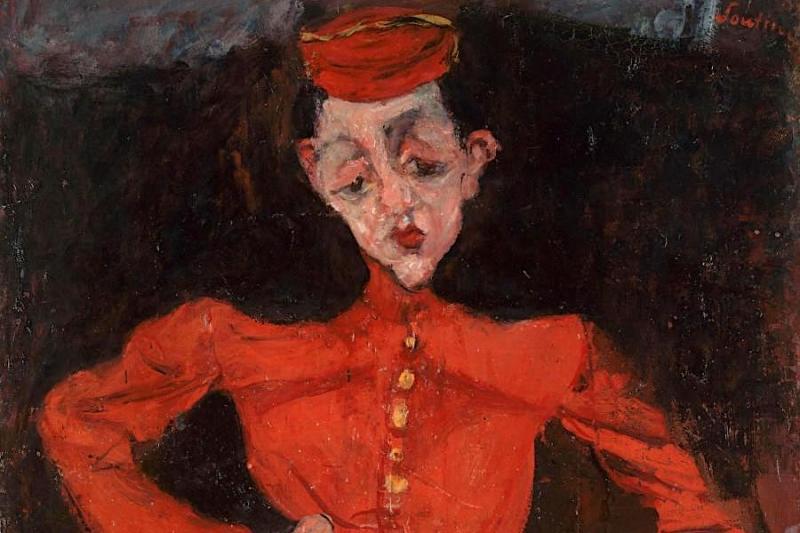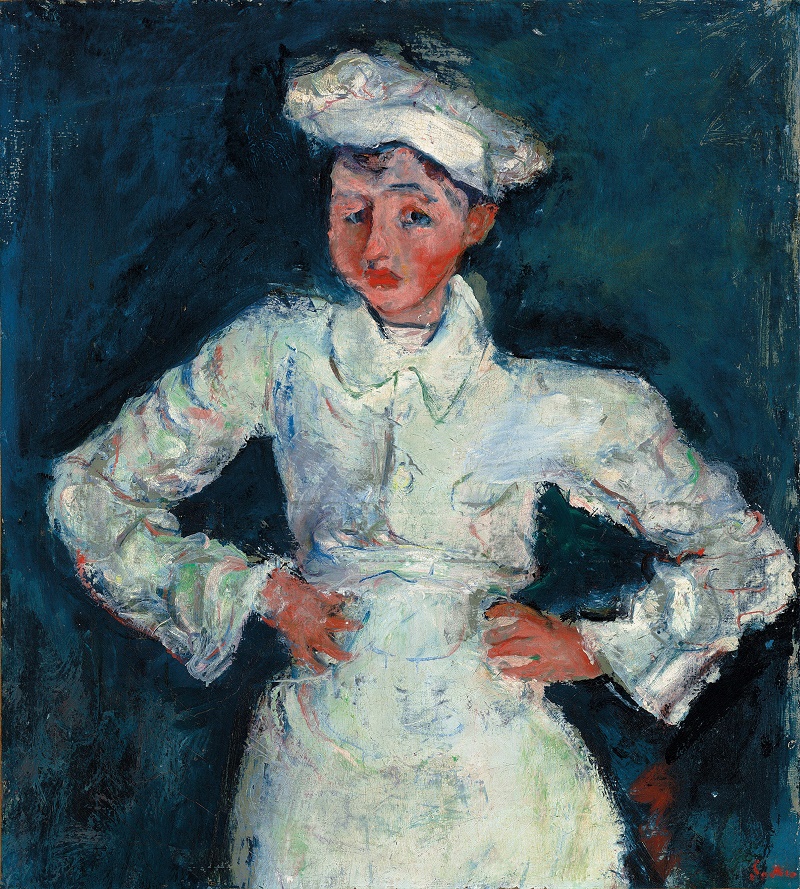Soutine's Portraits, Courtauld Gallery review - a superb, unsettling show | reviews, news & interviews
Soutine's Portraits, Courtauld Gallery review - a superb, unsettling show
Soutine's Portraits, Courtauld Gallery review - a superb, unsettling show
Humanity writ large in cooks, waiters and bellboys by French-Russian portraitist

This is the latest in a line of beautifully curated, closely focused exhibitions that the Courtauld Gallery does so well. Its subject is the great Russian-French painter Chaim Soutine (1893-1943) who, remarkably, has not had a UK exhibition devoted to his work for 35 years.
For those who admire Soutine, it is usually his extraordinary series of hung beef carcasses – raw, bloody, with limbs splayed like flayed martyrs – that come first to mind. It is tempting initially to view his portraits in the same light. An early portrait of a Butcher’s Boy, c.1919-20 (pictured below right, © Courtauld Gallery, private collection), uses the blood-red of the butcher’s curtain (which protected the meat from flies), the slash and burn of paint, and the bloody raw materiality of flesh. But the majority of these portraits seem to speak more of Chaim’s intense identification with immigrants and outsiders, as well as his passionate interest in creating a vital new chapter in the history of portraiture.
 Soutine brings his various characters to life in a deeply subjective manner. His approach is often described as visceral: an early champion described his writhing paintings of landscapes, faces and the like as giving off "a profound heat". It is often impossible to determine whether Soutine is expressing his own intensity and sensitivity through an identification with his various sitters, or commenting on their complex reality, or focusing on their role as a working type within a grand art-historical tradition, or revealing his frustration with the process of painting a living model – or indeed a mixture of all four.
Soutine brings his various characters to life in a deeply subjective manner. His approach is often described as visceral: an early champion described his writhing paintings of landscapes, faces and the like as giving off "a profound heat". It is often impossible to determine whether Soutine is expressing his own intensity and sensitivity through an identification with his various sitters, or commenting on their complex reality, or focusing on their role as a working type within a grand art-historical tradition, or revealing his frustration with the process of painting a living model – or indeed a mixture of all four.
A waiting maid’s homely face with small pinched mouth and pointed chin has the stooped head and exaggeratedly large, downcast eyes that Soutine often uses to suggest a melancholic and unfathomable interior world. She wears her apron as a badge of office and also a yoke of servitude, but Soutine’s main delight is in painting the apron bib’s whites with its streaks of colour. Nearby, a portrait of a boy in uniform, with arched eyebrows and assertive gaze, shows how brazen a youth can feel when he dons such garb. But another portrait of a thin valet, with an air of meek gentleness, large elfin ears, a full mouth and slightly cross eyes, has a profoundly moving presence while also speaking eloquently of the influence of the soulful portraits of the Spanish Old Master El Greco.
 Two female portraits of a cook show how Soutine used old-master portrait formats and his own reaction to the fashion for sentimental portrayals of working people to up-end a tradition that had for too long had it both ways (pictured right, The Little Pastry Cook, 1927 © Courtauld Gallery, Lewis Collection). They depict the same model, and use the full-length format that was usually reserved for grand sitters, but Soutine, through compressing the space and tilting the figure, captures something of the oppression of the soul. They are almost painful in their depiction of the twisted face, drooping eye, clasped hands, and poignant femininity, glimpsed in the thin legs and pointed shoes.
Two female portraits of a cook show how Soutine used old-master portrait formats and his own reaction to the fashion for sentimental portrayals of working people to up-end a tradition that had for too long had it both ways (pictured right, The Little Pastry Cook, 1927 © Courtauld Gallery, Lewis Collection). They depict the same model, and use the full-length format that was usually reserved for grand sitters, but Soutine, through compressing the space and tilting the figure, captures something of the oppression of the soul. They are almost painful in their depiction of the twisted face, drooping eye, clasped hands, and poignant femininity, glimpsed in the thin legs and pointed shoes.
A series of four paintings of a red-haired Head Waiter/Valet/Room Service Waiter, c.1927, illustrates a different set of creative challenges. In the first portrait, one can imagine Soutine saying to the model: "Give me a contemptuous head waiter …" The second portrait (Valet) is less assertive; the model seems to droop before us as his hands flatten to his thighs, his features drip and the brilliant waistcoat bulges awkwardly like the unbound breasts of an old woman. In the third portrait, which becomes almost an angry caricature of both the subject and Soutine’s mannerisms, the subject looms towards the painter. We know from X-rays that Soutine lacerated the original canvas in frustration. He explained to a friend how important it was for him to take his time, but how the model could tire quickly and assume a stupid expression. Irritation would then escalate into a state of agony: "I become unnerved, I grind my teeth, and sometimes it gets to the point where I scream, I slash the canvas, and everything goes to hell and I fall down on the floor." (Pictured below: Valet, c.1927 © Courtauld Gallery, Lewis Collection)
 A startling portrait entitled Page Boy at Maxim’s, c.1927, seems to contrast the wretched state of this servile youth (his large hand proffered in hope of a tip) with the opulent papal red of his uniform with its shiny gold buttons. The gaunt face, black eyes and emaciated form beneath the jacket and cap reveal a modern man of sorrows. A more extreme portrait of a Bellboy, c.1925 (main picture), boasts the same garish red uniform, but poses the figure in a way that is strident and unsettling: the large misshapen reddened ears that stick out like jug handles are echoed by the lopsided wings of the shoulders, the ballooning thrust of hands on hips, and the spread-eagled legs. Even more affecting is the flagrant sexuality of the pose coupled with the awkwardness of the boy’s demeanour.
A startling portrait entitled Page Boy at Maxim’s, c.1927, seems to contrast the wretched state of this servile youth (his large hand proffered in hope of a tip) with the opulent papal red of his uniform with its shiny gold buttons. The gaunt face, black eyes and emaciated form beneath the jacket and cap reveal a modern man of sorrows. A more extreme portrait of a Bellboy, c.1925 (main picture), boasts the same garish red uniform, but poses the figure in a way that is strident and unsettling: the large misshapen reddened ears that stick out like jug handles are echoed by the lopsided wings of the shoulders, the ballooning thrust of hands on hips, and the spread-eagled legs. Even more affecting is the flagrant sexuality of the pose coupled with the awkwardness of the boy’s demeanour.
Soutine, an immigrant from Lithuania, had himself arrived penniless in Paris in 1913, determined to make it as a painter. In these portraits of mostly immigrant workers, together with the Old Masters in the Louvre, he found the subject and the inspiration that were to transform his fortunes. Among the first of these portraits was that of a Pastry Cook. c.1919-20, which so impressed the American collector Dr Albert Barnes that he immediately bought more than 50 of Soutine’s pictures. His purchase made Soutine rich, and the painters’ later American retrospective in 1950 featured another extravagantly dressed and painted Pastry Cook, c.1922-3, that would have a huge influence on painters like Willem De Kooning. Now, we too can appreciate how Soutine’s portraiture gets under the skin.
The future of Arts Journalism
You can stop theartsdesk.com closing!
We urgently need financing to survive. Our fundraising drive has thus far raised £49,000 but we need to reach £100,000 or we will be forced to close. Please contribute here: https://gofund.me/c3f6033d
And if you can forward this information to anyone who might assist, we’d be grateful.

Subscribe to theartsdesk.com
Thank you for continuing to read our work on theartsdesk.com. For unlimited access to every article in its entirety, including our archive of more than 15,000 pieces, we're asking for £5 per month or £40 per year. We feel it's a very good deal, and hope you do too.
To take a subscription now simply click here.
And if you're looking for that extra gift for a friend or family member, why not treat them to a theartsdesk.com gift subscription?
more Visual arts
 'We are bowled over!' Thank you for your messages of love and support
Much-appreciated words of commendation from readers and the cultural community
'We are bowled over!' Thank you for your messages of love and support
Much-appreciated words of commendation from readers and the cultural community
 Folkestone Triennial 2025 - landscape, seascape, art lovers' escape
Locally rooted festival brings home many but not all global concerns
Folkestone Triennial 2025 - landscape, seascape, art lovers' escape
Locally rooted festival brings home many but not all global concerns
 Sir Brian Clarke (1953-2025) - a personal tribute
Remembering an artist with a gift for the transcendent
Sir Brian Clarke (1953-2025) - a personal tribute
Remembering an artist with a gift for the transcendent
 Emily Kam Kngwarray, Tate Modern review - glimpses of another world
Pictures that are an affirmation of belonging
Emily Kam Kngwarray, Tate Modern review - glimpses of another world
Pictures that are an affirmation of belonging
 Kiefer / Van Gogh, Royal Academy review - a pairing of opposites
Small scale intensity meets large scale melodrama
Kiefer / Van Gogh, Royal Academy review - a pairing of opposites
Small scale intensity meets large scale melodrama
 Jenny Saville: The Anatomy of Painting, National Portrait Gallery review - a protégé losing her way
A brilliant painter in search of a worthwhile subject
Jenny Saville: The Anatomy of Painting, National Portrait Gallery review - a protégé losing her way
A brilliant painter in search of a worthwhile subject
 Abstract Erotic, Courtauld Gallery review - sculpture that is sensuous, funny and subversive
Testing the boundaries of good taste, and winning
Abstract Erotic, Courtauld Gallery review - sculpture that is sensuous, funny and subversive
Testing the boundaries of good taste, and winning
 Edward Burra, Tate Britain review - watercolour made mainstream
Social satire with a nasty bite
Edward Burra, Tate Britain review - watercolour made mainstream
Social satire with a nasty bite
 Ithell Colquhoun, Tate Britain review - revelations of a weird and wonderful world
Emanations from the unconscious
Ithell Colquhoun, Tate Britain review - revelations of a weird and wonderful world
Emanations from the unconscious
 Rachel Jones: Gated Canyons, Dulwich Picture Gallery review - teeth with a real bite
Mouths have never looked so good
Rachel Jones: Gated Canyons, Dulwich Picture Gallery review - teeth with a real bite
Mouths have never looked so good
 Yoshitomo Nara, Hayward Gallery review - sickeningly cute kids
How to make millions out of kitsch
Yoshitomo Nara, Hayward Gallery review - sickeningly cute kids
How to make millions out of kitsch
 Hamad Butt: Apprehensions, Whitechapel Gallery review - cool, calm and potentially lethal
The YBA who didn’t have time to become a household name
Hamad Butt: Apprehensions, Whitechapel Gallery review - cool, calm and potentially lethal
The YBA who didn’t have time to become a household name

Add comment